Explore the latest news and find out what's on this month
Explore our learning offer for schools, families and community groups
Uncover the rich history of Elmbridge with our latest online exhibitions
Want to discover more about your local area?
Explore the latest news and find out what's on this month
Explore our learning offer for schools, families and community groups
Uncover the rich history of Elmbridge with our latest online exhibitions
Want to discover more about your local area?
Elmbridge has had some notable residents from glamorous actresses like Alma Taylor, to royals such as Princess Charlotte, the daughter of George IV. The borough has been the author of many a life-story, whether full of success or sadness.
In 2018 Elmbridge Museum held a temporary exhibition at the Riverhouse Barn to celebrate the lives of significant people from our borough. This online exhibition features some of the stories we told. Meet the past faces of Elmbridge and see how they helped to shape the borough that we live and work in.
Some of those featured in this exhibition have left a fleeting impression as they passed through the borough: those like Queen Victoria and the current Prince Charles. These figures have drawn together and divided communities, paving the way to modernity.
The people of Elmbridge have made an impact on the societies they lived in and their likenesses have been preserved in paint, sculpture, pencil, pastel and other mediums for us to remember.
This exhibition charts the human story of the individuals who once inhabited our area and shines a light on their biggest achievements, darkest moments and most intriguing tales.
1921 – 1944
Peter was a Weybridge local who was killed in action fighting with the Indian regiment, the 1st Battalion of the 5th Mahratta Light Infantry.
During the Second World War, the regiment served in North Africa and Italy. Peter was only twenty-two when he died in 1944, and is buried at Sangro River War Cemetery in Italy.
Ada was the only legitimate daughter of Lord Byron. She was never familiar with her father as he left England when she was only a few months old and died in Greece when she was 8.
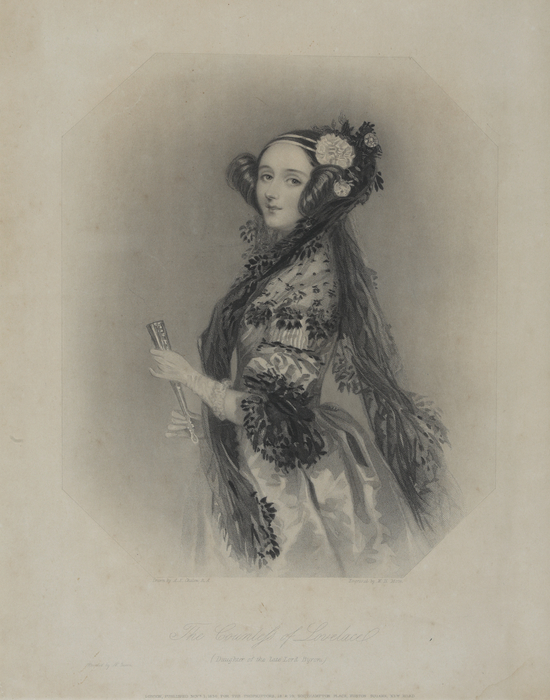
Print of Ada Lovelace, 19th Century, W.H. Mote after A.E. Chalon.
Ada was a gifted mathematician who worked on complex computer concepts with the inventor of the computer, Charles Babbage. She theorised a method for Babbage’s invention, the ‘analytical engine’, to repeat a series of instructions. This is something which is now practiced by modern computers and is more commonly known as ‘looping’.
In 1835, marriage to William King-Noel, the Earl of Lovelace, brought Ada to Esher’s Sandown House where she settled for the rest of her life. She is the famous aunt, by marriage, of Brooklands racetrack founder, Hugh Locke King.
Fanny Kemble was an actress who made her debut on the London stage as the lead female in the classic Shakespeare love story, Romeo and Juliet. She was born in London and when she was young lived at Eastlands in Weybridge whilst it was still a country retreat, bordered by Oatlands and Portmore Parks.
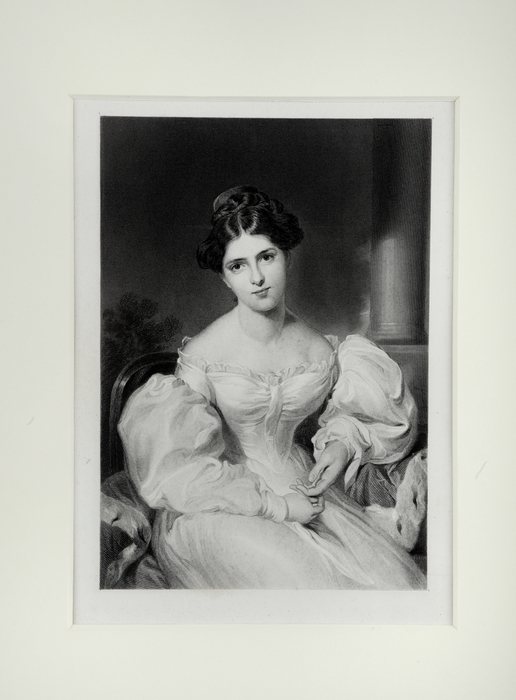
Print of Fanny Kemble, 19th Century, after Sir Thomas Lawrence.
In 1834 on a trip around America with her father, she married Pierce Butler who was the heir to large plantations in Georgia and North Carolina. On starting a family with him, she quickly became aware of the reality of plantation life and the inhumane treatment of slaves. Fanny became a dedicated supporter of the abolition of the slave trade, writing journals which expressed her strong feelings about the pain and terror she saw the plantation workers go through.
The publishing of Fanny’s journals resulted in divorce and she eventually moved back to London to return to acting.
Pastel portrait of ‘The Hon. Peter Locke King M.P.’, by H.T. Wells c.1878.
Peter Locke King was the MP for East Surrey from 1847 to 1874 and was a major advocate of reform. He was responsible for the passing of the Real Estate Changes Act of 1854 and supported alterations to the law of primogeniture (inheritance through the male line).
Peter was the brother of the Earl of Lovelace and the father of Hugh Locke King, who was his only surviving son. Peter Locke King built Brooklands House in 1862 where he lived with his family, dying there in 1885. After his father’s death, Hugh Locke King went on to develop the Brooklands Estate, creating a motor racing track which became world famous.
This pastel was exhibited at the Royal Academy in 1878 and a note on the back states that this sketch was a study for an oil painting of Peter Locke King now in the collection of Brooklands Museum.
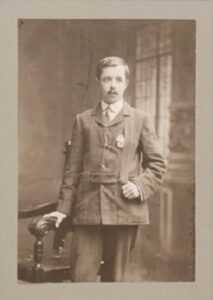
Reproduction photograph of Frederick W Braddock from a negative by J.W. Debenham, early 1900s.
Frederick was employed as an apprentice for five years at the Thames Ditton Bronze Foundry in 1897, where he progressed to later became sand-moulder and Chief Assistant. The Thames Ditton Bronze Foundry cast a significant number of bronze statues, plates and figurines within the United Kingdom and Commonwealth.
King George V and Queen Mary visited the Foundry in 1921, where they inspected Sir Thomas Brock’s equestrian statue of Edward VII. The photographs of the day were taken by Frederick Braddock, in his capacity as foundry foreman, and are now in the collection of the National Portrait Gallery!
1903-1976
Amy Gentry was a pioneer of women’s rowing in the United Kingdom. She founded a ladies’ section at Weybridge Rowing Club in 1920 and started Weybridge Ladies Amateur Rowing Club in 1926. She chaired WLARC for the rest of her life and dedicated her time to promoting women’s rowing. She was awarded an O.B.E. for her services to rowing in 1969.
Amy experienced personal success in the British single sculls when she became champion in 1932, 1933 and 1934. In mixed double sculls, with her brother Frank, she won consecutive victories from 1924 to 1926.
The Women’s European Rowing Championships were held in London in 1960 because Amy persuaded the International Rowing Federation to bring the event to the UK. Owing a great debt to Amy, female athletes competed in rowing races for the first time at the 1976 Olympics in Montreal.
This item is on loan to Elmbridge Museum from Weybridge Ladies Amateur Rowing Club.
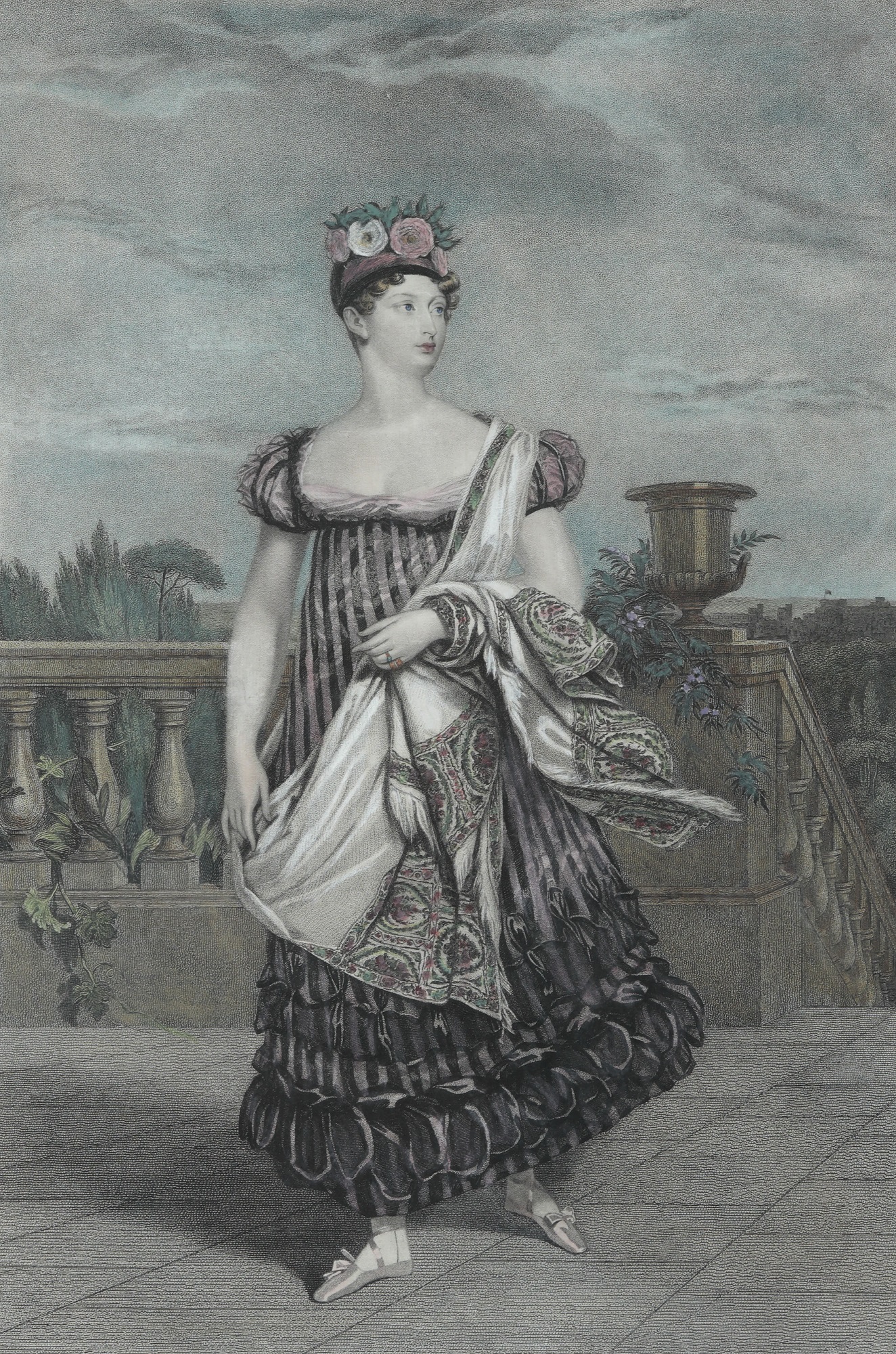 Hand-coloured print of Princess Charlotte of Wales, 1816. Original by Henry Meyer; engraved by Alfred Chalon.
Hand-coloured print of Princess Charlotte of Wales, 1816. Original by Henry Meyer; engraved by Alfred Chalon.
1796-1817
Princess Charlotte was the original ‘People’s Princess’. She was the only daughter of George IV and Princess Caroline of Brunswick. Her parents split just weeks after their marriage and feuded for the entirety of Charlotte’s upbringing.
Princess Charlotte’s lonely upbringing away from both parents resulted in her becoming headstrong and plain-spoken. In 1813 she refused to marry Prince William of Orange, breaking off the engagement because she would not relocate to Holland.
Princess Charlotte married the love of her life, Prince Leopold, on 2nd May 1816. The happy couple honeymooned at Oatlands Park in Weybridge and decided to move to the area. They moved into Esher’s Claremont where Princess Charlotte enjoyed giving patronage to local tradesmen.
The announcement of Princess Charlotte’s pregnancy in April 1817 was met by jubilation, but there were problems with the birth. After a lengthy labour lasting fifty hours, the Princess gave birth to a stillborn son on 6 November. She sadly died very shortly afterwards at the age of only twenty-one.
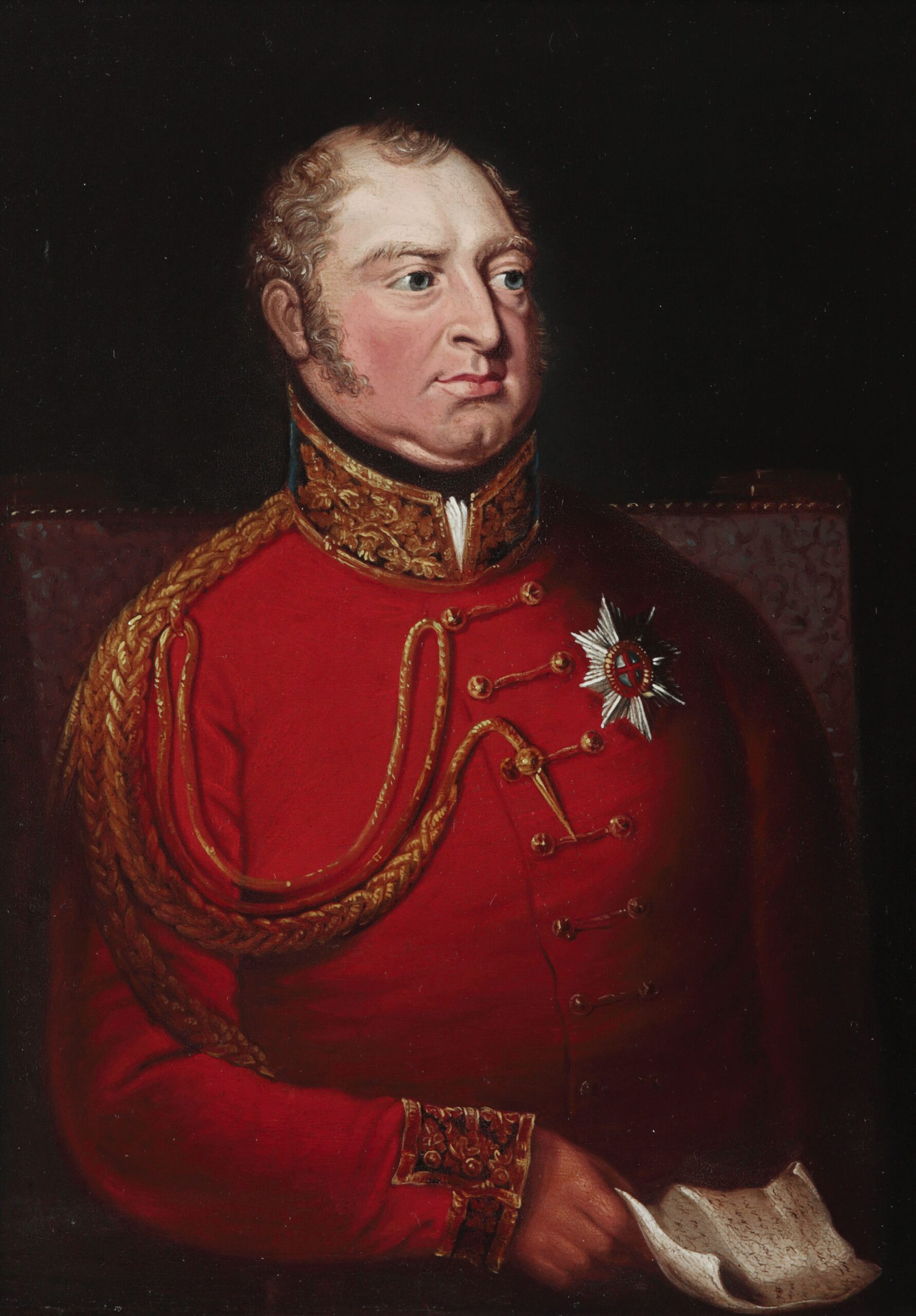 Oil painting portrait of the Duke of York in full dress uniform, c. late 1700s. Artist unknown.
Oil painting portrait of the Duke of York in full dress uniform, c. late 1700s. Artist unknown.
1763-1827
The Duke of York was the second son of George III and is shown here in military uniform to reflect his successful career in the army. Prince Frederick rose rapidly through the military ranks, becoming Field Marshal and then Commander-in-Chief at little more than thirty years old.
It may help to put a face to the name of the character we hear described in the popular children’s nursery rhyme:
“The grand old Duke of York,
He had ten thousand men.
He marched them up to the top of the hill and he marched them down again.
And when they were up, they were up.
And when they were down, they were down.
And when they were only halfway up, they were neither up nor down.”
The Duke of York married Princess Frederica of Prussia in 1791. The couple lived at Oatlands House from 1794 but the marriage was unhappy, and the Duke kept a mistress nearby at Columb’s House. After they separated, the Duchess of York chose to see out the rest of her days at Oatlands House with a large menagerie of pets. It is she that the York Column at the top of Weybridge High Street memorialises.
1819-1901
Queen Victoria held the record for the longest reigning English monarch in history, until it was recently broken by Queen Elizabeth II. As the daughter of George III’s fourth son, it was never expected that she would be Queen. Her reign was generally one of domestic stability that saw changes in infrastructure, law, science and the military.
This bronze of Queen Victoria was made to commemorate her Diamond Jubilee (sixty years), in 1897. The sculptor, Francis John Williamson, was a favourite of Queen Victoria, receiving Royal Patronage in 1870 and exhibiting work at the Royal Academy. He lived in Esher from 1856 to his death in 1920 and over thirty of his sculptures were cast at the Thames Ditton Bronze Foundry.
Charles Philip Arthur George, Prince of Wales
b.1948
Prince Charles is an enthusiastic supporter of the arts and charities such as The Prince’s Trust, which he founded in 1976.
He is probably best known for his highly-publicised relationship with his ex-wife, Lady Diana Spencer. Their divorce in 1996 was followed by Diana’s death a year later, and Charles received much criticism in the media. In 2005, Charles married Camilla Parker Bowles at St George’s Chapel in Windsor Castle.
Prince Charles is imagined in this oil painting to be about sixteen, and is wearing royal robes and a crown.

Leslie Banks was an actor who, because of an injury during the First World War, experienced scarring to one side of his face.
He embraced his new characteristics to play menacing characters in films in the 1930s.
Alma Taylor was film producer Cecil Hepworth’s favourite actress and he would boast of her natural beauty, disallowing her to wear makeup in his films.
Alma starred in more than one hundred silent movies and was one of the Hepworth Players. Her roles included playing Tilly in the ‘Tilly the Tomboy’ series, Helen in ‘Comin’ Thro the Rye’, and Lilian in ‘Shadow of Egypt’, which was shot on location.
Jessie was a stage actress from Soho who became known as the English Ginger Rodgers. She enjoyed some success in musical films but fell out of favour after the Second World War.
Jessie starred in some Nettlefold Studios films, which were shot at the Walton-on-Thames studios. She had a difficult life plagued with relationship breakdowns and bad health.
Douglas had success as an actor in Hollywood but was overshadowed by his father who had starred in ‘Mark of Zorro’, ‘Robin Hood’ and ‘The Three Musketeers’ in the 1920s.
After falling out with Hollywood in the 1930s, he moved to Britain and starred in some British films.
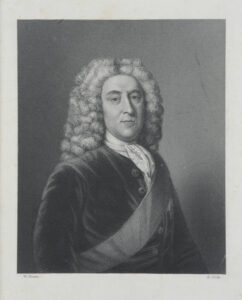
Print of Thomas Holles-Pelham, Duke of Newcastle, c. mid-1700s. Artist unknown.
Thomas Holles-Pelham, was the owner of the first house built on the Claremont estate in Esher in 1708. Claremont house was built by the famous architect Sir John Vanbrugh and was a hub of social activity and politics. The original house was replaced by Lancelot ‘Capability’ Brown on a different site later in the eighteenth century and is now home to Claremont Fan School.
Holles-Pelham was married to Lady Henrietta Godolphin and though the couple had no children, they seem to have been happy together, with the Duke writing to his wife every day when they were apart. His personality was described by Lord Stanhope: ‘His peculiarities were so glaring and ridiculous that the most careless glance could not mistake, nor his most bitter enemy exaggerate them’.
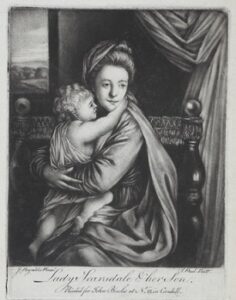
Print of Caroline Colyear, Lady Scarsdale, c.mid-1700s.
Lady Caroline was the granddaughter of Catherine Sedley, a former mistress of King James II. The Colyears were the Earls of Portmore, holding a seat at Weybridge’s Portmore Park, which had been given to Catherine for her services to the crown.
Caroline became Lady Scarsdale on her marriage to Nathaniel Curzon whose family home was Kedleston Hall in Derbyshire. She is pictured here with one of their seven children, most likely to be their eldest son Nathaniel who became 2nd Lord Scarsdale.
Learn more about Portmore Park and Caroline's grandmother, Catherine Sedley, in our High Street Heritage Trail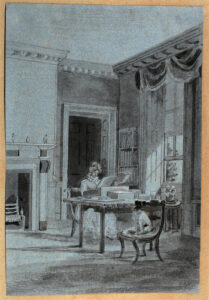
Sketch, 19th Century, My Little Room by Lady Mary Elizabeth Bennett.
Lady Mary Elizabeth Bennett was the daughter of the 4th Earl of Tankerville and Emma Colebrook. She spent her youth at Mount Felix in Walton-on-Thames, helping the family gardener to grow new varieties of tri-coloured viola pansies.
Trained by the London artist John Varley, Lady Mary became a successful watercolour artist, producing numerous works which are now mostly in private collections. This sketch is an early self-portrait of the artist working at her desk.
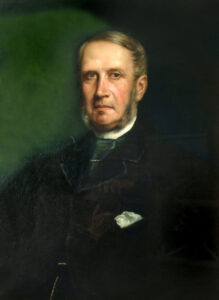
Oil on Canvas portrait of John Philip Fletcher, c.1870. Artist unknown.
This mysterious gentleman is known only as John Philip Fletcher. He is probably the grandson of Sir Captain Henry Fletcher, who was MP for Cumberland and a Director of the East India Company in the late 1700s. Sir Henry Fletcher inherited the Ashley Park Estate in Walton-on-Thames in 1786 and the family seat was established there. Sir Captain Henry Fletcher left Ashley House to his son on his death in 1807 and it passed through successive family members called Henry.
The John Philip Fletcher represented in this painting was the brother of one of the Henrys who owned Ashley House. John Philip Fletcher may have occupied Ruxley Lodge in Claygate, according to Edward Wedlake Bayley’s ‘History of Surrey’.
This painting came into the possession of the architect, Henry Walter Molyneux Sarel, who donated it to Elmbridge Museum in 1936. Could it be possible that Walter Sarel was involved in the demolition and redevelopment of Ashley House and Estate in the 1920s?
Oil on Canvas portrait of Robert Gill, c.1831, by William Bradley.
1796-1871
Robert Gill was a railway pioneer who lived at Apps Court in Walton-on-Thames with his family. Robert worked with his good friend George Stephenson building Railways and was present at the opening of the Manchester and Liverpool line in 1830.
Robert was also a sensible businessman and bought into the idea of purchasing the Crystal Palace after the closure of the Great Exhibition in 1851. He was involved in its re-erection at Sydenham and remained on the board of directors for many years.
Depicted here at about thirty-five, Robert was already working on the railways. An enthusiastic supporter of innovation and modernity, he kept a presence on site and in parliament. He dug the first turf for the Manchester and Leeds railway line in 1837.
Pastel portrait of Frederica Gill (left) and Madeline Gill (right), by Charles Allen Duval, 1858.
Frederica and Madeline were the first and third oldest daughters of railway pioneer Robert Gill. Madeline lived a short life, dying aged only seventeen but Frederica was still living at Apps Court with her mother and siblings in 1881 for the census.
Charles Duval has drawn the girls in their youth in a double portrait, which is a compositional style he is well-known for. His most famous work is the pastel portrait of the three eldest daughters of the novelist Elizabeth Gaskell. Duval executed his portraits in pastel, chalk, oil and watercolour and regularly exhibited work at the Royal Academy.
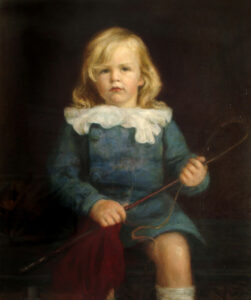
Oil on canvas portrait of Robert John Brooke Gill, by Lance Outram c.1913.
1911 – ?
This entrancing young toddler is Robert John Brooke Gill, the grandson of Robert Gill. He was born in 1911, the son of John Seppings Gill, and lived with the family at The Vicarage in Frensham, Farnham.
He is shown here aged two with wavy blonde hair holding a riding whip and a piece of red cloth.
The Elmbridge Hundred site is a database maintained by Elmbridge Museum. Here you can find details of the hundred figures in Elmbridge's history deemed the most significant or famous, and also browse over 700 other notable names.
Go to the Elmbridge Hundred now
Tell us your thoughts!
Who stands out for you amongst the historic 'People of Elmbridge'? Let us know by leaving a comment!You need to be logged in to comment.
Go to login / register